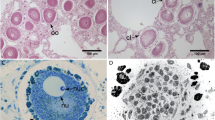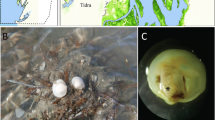Abstract
Arising from: J. V. Bailey, S. B. Joye, K. M. Kalanetra, B. E. Flood & F. A. Corsetti Nature 445, 198–201 (2007)10.1038/nature05457; Bailey et al. reply
Bailey et al.1 propose that the Ediacaran microfossils Megasphaera and Parapandorina, previously interpreted as animal resting eggs and blastula embryos2, represent Thiomargarita-like sulphide-oxidizing bacteria, claiming that this interpretation better explains their abundance and taphonomy. Here we highlight important observations that significantly weaken the authors' conclusions.
This is a preview of subscription content, access via your institution
Access options
Subscribe to this journal
Receive 51 print issues and online access
$199.00 per year
only $3.90 per issue
Buy this article
- Purchase on Springer Link
- Instant access to full article PDF
Prices may be subject to local taxes which are calculated during checkout

Similar content being viewed by others
References
Bailey, J. V., Joye, S. B., Kalanetra, K. M., Flood, B. E. & Corsetti, F. A. Nature 445, 198–201 (2007); published onlne 20 December 2006, doi:10.1038/nature05457.
Xiao, S., Zhang, Y. & Knoll, A. H. Nature 391, 553–558 (1998).
Xiao, S. & Knoll, A. H. J. Paleontol. 74, 767–788 (2000).
Yuan, X. et al. Doushantuo Fossils: Life on the Eve of Animal Radiation (China Univ. of Science and Technology Press, Hefei, China, 2002).
Chen, J.-Y. The Dawn of Animal World (Jiangsu Science and Technology, Nanjing, 2004).
Xiao, S., Hagadorn, J. W., Zhou, C. & Yuan, X. Geology 35, 115–118 (2007).
Yin, C., Bengtson, S. & Yue, Z. Acta Palaeontol. Polon. 49, 1–12 (2004).
Hagadorn, J. W. et al. Science 314, 291–294 (2006).
Donoghue, P. C. J. Nature 445, 155–156 (2007).
Xiao, S. & Knoll, A. H. Lethaia 32, 219–240 (1999).
Dornbos, S. Q. et al. Palaios 21, 3–14 (2006).
Zhang, Y., Yin, L., Xiao, S. & Knoll, A. H. Paleontol. Soc. Mem. 50, 1–52 (1998).
Author information
Authors and Affiliations
Corresponding author
Ethics declarations
Competing interests
The authors declare no competing financial interests.
Rights and permissions
About this article
Cite this article
Xiao, S., Zhou, C. & Yuan, X. Undressing and redressing Ediacaran embryos. Nature 446, E9–E10 (2007). https://doi.org/10.1038/nature05753
Received:
Accepted:
Published:
Issue Date:
DOI: https://doi.org/10.1038/nature05753
This article is cited by
-
Ultrastructure and in-situ chemical characterization of intracellular granules of embryo-like fossils from the early Ediacaran Weng’an biota
PalZ (2021)
-
Cell differentiation and germ–soma separation in Ediacaran animal embryo-like fossils
Nature (2014)
-
The Lantian biota: A new window onto the origin and early evolution of multicellular organisms
Chinese Science Bulletin (2013)
-
Undressing and redressing Ediacaran embryos (Reply)
Nature (2007)
Comments
By submitting a comment you agree to abide by our Terms and Community Guidelines. If you find something abusive or that does not comply with our terms or guidelines please flag it as inappropriate.



